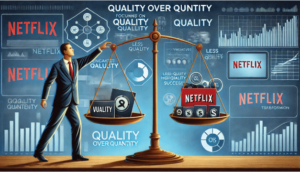

Let’s be honest—we’ve all taken a few punches the last few years. Some of us are just now starting to breathe a little easier. The waters are calming, sure… but don’t get too comfortable. This ain’t smooth sailing just yet.
Yeah, the headlines tell you unemployment’s down and people are spending. But let’s not kid ourselves—there’s still plenty of economic weirdness bubbling under the surface. Wages haven’t kept up, costs are still up, and way too many folks are cobbling together part-time gigs when they really need full-time work.
So what does that mean for business owners like you and me? It means building and growing in this kind of climate is like trying to steer a rowboat in a windstorm. Especially if you’re a small business still licking your wounds or running lean—it’s rough out there.
But here’s the deal: tough environments don’t stop winners. They sharpen them.
Over the next couple months, I’m going to use this space to hammer on how you can build a business that lasts. One that grows, survives, and thrives no matter what curveballs the economy throws. This is for the builders, the scrappers, the ones willing to roll up their sleeves and do what needs to be done.
It’s not about doom and gloom. It’s about getting real, getting prepared, and getting to work.

I’ve said it before and I’ll keep saying it: The most dangerous number in business is ONE. One customer, one product, one marketing channel… you’re walking a tightrope with no safety net.
Remember when Google yanked the rug out from under thousands of advertisers back in the 2000s? Businesses that had built their entire lead gen strategy on Google Ads woke up one day to find their traffic—and revenue—gone. No warning. No recourse. Just gone.
That’s what happens when your entire growth engine is tied to a single method.
I just reconnected with a client I’ve worked with off and on for over a decade. Used to be they were all-in on one channel. Now? They’ve got eight—including direct mail, which still delivers a rock-solid ROI year after year. Their old method was losing steam, but they didn’t panic. They pivoted. Smart move.
So, what should you, the savvy entrepreneur, be doing? Three things:
When times get tough, some businesses reach for the panic button and start slashing prices. I get the temptation—but it’s usually the start of a slow bleed.
I’ve seen restaurants do this. Drop prices to get butts in seats. But that short-term sugar high? It doesn’t last. And now many of those brands are teetering on the edge of bankruptcy.
Here’s the hard truth: You’re not Walmart. You’re not Amazon. You don’t have the margin to race to the bottom.
The answer isn’t to sell for less—it’s to sell better.
Know your numbers cold. I’m talking about margins, acquisition costs, lifetime value. (Side note: Check out Chapter 43 of Dan Kennedy’s No B.S. Ruthless Management of People and Profits—it’s pure gold.)
Then look at who you’re selling to. Maybe your offers attract bargain hunters who’ll ditch you the second someone else drops a coupon. If so, it’s time to upgrade your audience.
**Bundling, premium versions, smarter messaging, tighter positioning—**all of these can let you raise prices and increase value at the same time.
You can’t compete on price and survive long term. But you can compete on value, uniqueness, and message-to-market match.
And if you’re thinking, “I’ll just lower my prices to compete,” let me stop you right there. I’ve watched multi-million-dollar companies run themselves straight into the ground doing that. Once you start chasing cheaper, there’s no bottom.

Everyone’s chasing scale. Bigger lists. More leads. More traffic. But more isn’t always better. Look at Netflix. In the early days, it was all about how many titles they had. Now? It’s about the quality of the content. Original shows. Award winners. Binge-worthy stuff that keeps people subscribed.
They traded volume for value—and it worked. You should be doing the same.
Instead of trying to grab everyone, focus on your best buyers. The ones who stick around. The ones who don’t quibble about price. The ones who rave about you to friends.
Figure out who they are, and get laser-focused on finding more of them. It’s not about stuffing your funnel—it’s about refining it. That means better segmentation, stronger offers, and more personalized marketing. More “just okay” customers won’t build a great business. Fewer right-fit customers will.
Using the Dream 100 marketing strategy is a great way to go about finding quality over quantity. You can read about how to recession proof your business and the Dream 100 strategy here.
The digital revolution has somewhat depersonalized the art of salesmanship, with many businesses relying heavily on online marketing and passive selling techniques. Remember when everyone knew the name of the person who sold them their car, insurance, or even a TV? There’s magic in that personal touch, and guess what? It’s making a comeback.
Direct selling is evident in the success of companies like Peloton. Peloton combines cutting-edge technology with personalized sales tactics, offering live and on-demand fitness classes that create a community feel. Their approach reiterates that successful businesses need to re-embrace direct and personal salesmanship, adapting it to the modern consumer’s desire for connection and personalization.
Bringing back that old-school charm of talking to your customers, understanding what they’re all about, and giving them exactly what they need is key. Don’t hide behind your website or app. Get out there and make some real connections.
I love this video on salesmanship by Dan Kennedy.

Let’s cut to it: “Good enough” just isn’t good enough anymore.
If you’re out there offering the same thing everyone else is—just with a different label slapped on it—you’re on borrowed time. Today’s market isn’t just competitive… it’s brutal for businesses that blend in.
Want proof? Just look at Tesla. They didn’t win by being electric. That was just the entry ticket. They won because they made driving feel cool again. Because every inch of the customer experience—from the website to the steering wheel—feels like the future. It’s not just about the car. It’s about the mission, the tech, the identity.
They didn’t just sell transportation. They sold transformation.
And whether you sell cars, cupcakes, or coaching, that’s the game now.
This is your wake-up call! Being average is out. You’ve got to stand out by being amazing at what you do and how you do it. It’s about giving people something they can’t get anywhere else. And trust me, they’ll notice and love you for it.
So, what’s the big picture here? It’s simple, but also huge. Focus on making what you offer the best it can be—quality over quantity, every time. Get personal and really connect with your customers. And don’t just be good; be mind-blowingly great. Offer something so cool and unique that people can’t help but talk about it.
These days, to really make it, you’ve got to stand out to your peeps by being super relevant and offering them something they can’t get anywhere else. It’s all about giving them an amazing experience from the moment they find you too well after they’ve bought what you’re selling. Do this or risk getting left behind. You’ve got to have a deep, meaningful reason for being in the game. Just wanting to make money or get rich isn’t going to cut it. Tough, but true.
Netflix, Peloton, Tesla – they all did things differently and set new rules for the game. Take a page from their book and start writing your own success story. Let’s make your business not just another name out there but the name everyone can’t stop talking about.
Let’s be honest: a lot of businesses really needed a wake-up call because the market was seriously cluttered with too much of the same old stuff. It was about time for a major clean-up, and guess what? It’s happening right now.
There’s been way too much of the “just getting by” and “good enough” attitude, with everyone selling the same things with a different label. If you’ve been just cruising along, not really trying to stand out or do something special, then maybe it’s time for a change. Take a look around. We’re overflowing with options – cars, restaurants, dentists, you name it. Everyone’s offering the same basic thing. It’s time to ditch the ordinary and aim for the extraordinary. This is how you can use marketing to recession proof your business.
What you just read was first published in my monthly newsletter, The Copywriter’s Corner, and is also published in my 3D Mail Direct Marketing System. To get more information on the newsletter and the System, visit this link.
Add Your Comments